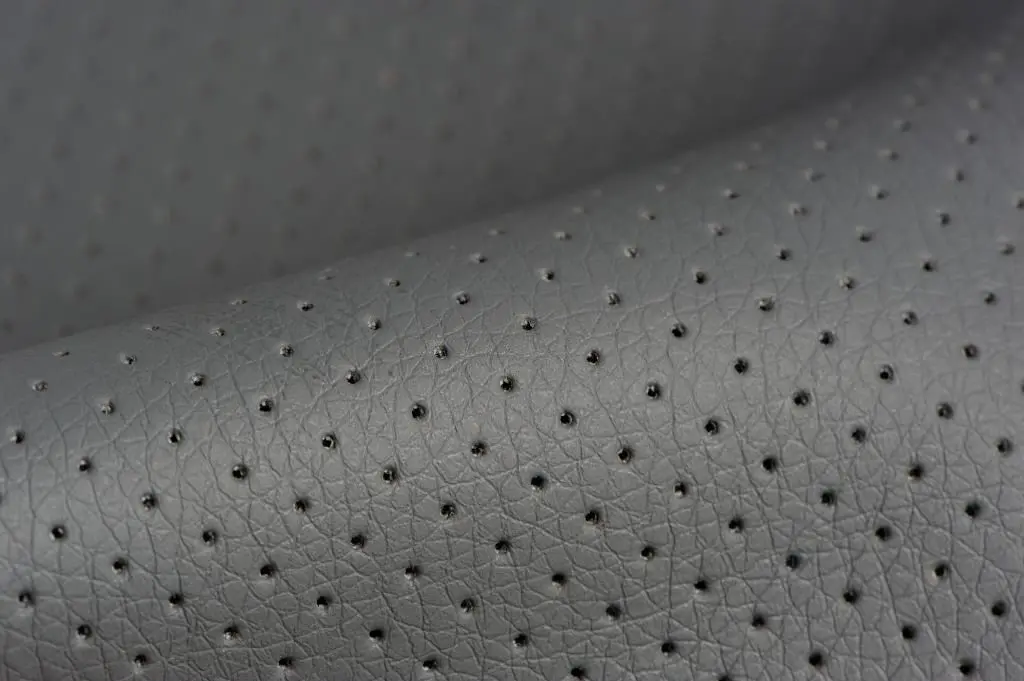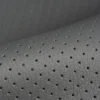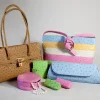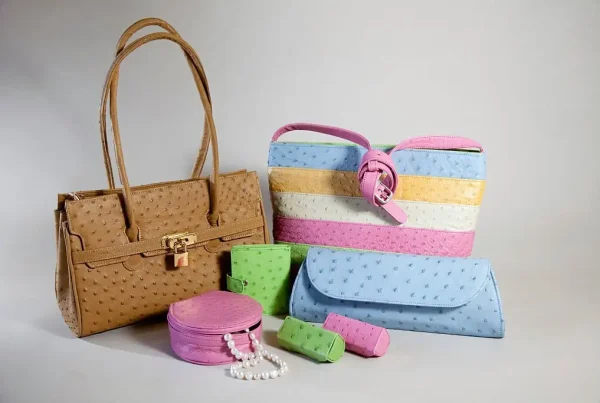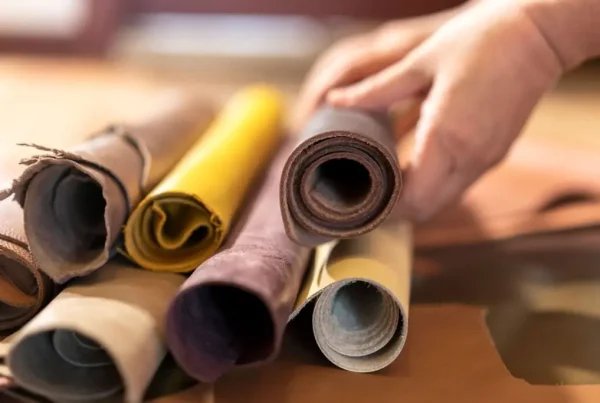Perforated leather is a remarkable material known for its versatility and wide range of applications. Whether you’re considering it for car seats, fashion, or other creative endeavors, understanding the essence of perforated leather is the first step in unlocking its magic.
What Is Perforated Leather?
Perforated leather is genuine leather that features small, strategically placed holes across its surface. These tiny perforations give it a distinctive appearance and unique qualities. Let’s delve into its defining characteristics.
The Making of Perforated Leather
Perforated leather is crafted through a precise hole-punching process. Skilled artisans or machines strategically create these perforations, ensuring consistency and precision in their placement. This meticulous process results in the distinctive appearance and functionality of perforated leather.
Section 2: Clearing Up Myths & Misconceptions
Myth 1: Perforated Leather is not as Durable as Solid Leather
Perforated leather is just as durable as solid leather when it’s properly maintained. The presence of small holes doesn’t compromise its structural integrity. In fact, the aeration provided by the perforations can enhance its longevity, as it helps prevent moisture buildup and keeps the leather in good condition.
Myth 2: Perforated Leather is More Expensive than Solid Leather
The cost of this leather can vary depending on factors like the type of leather used and the complexity of the perforation pattern. While some premium perforated leather may be more expensive, there are affordable options available. It’s essential to consider your budget and the specific project when choosing perforated leather.
Myth 3: Perforated Leather is More Difficult to Care for than Solid Leather
Caring for hole punched leather is straightforward. Regular cleaning and maintenance are key. Use a gentle leather cleaner and a soft brush to clean the perforations. The small holes may require a bit more attention, but it’s not significantly more challenging than caring for solid leather. Proper care will keep your perforated leather in top shape.
Myth 4: Perforated Leather is not as Stylish as Solid Leather
On the contrary, hole punched leather can be incredibly stylish and trendy. The small holes create a unique texture and visual appeal, making it a favorite among designers and fashion enthusiasts. It’s a versatile material that adds a touch of sophistication to various applications, from car interiors to fashion items.
Section 3: History of Perforated Leather
Origins of Perforated Leather
Perforated leather has a rich history dating back centuries. It originated from a need for both functional and decorative elements in various cultures. Early civilizations, such as the Egyptians and Romans, used hole punched leather for clothing and accessories. These perforations served multiple purposes, including ventilation and intricate design work.
Perforated Leather in the Middle Ages
During the Middle Ages in Europe, hole punched leather found its place in armor and clothing. Knights used it as part of their protective gear, combining functionality and aesthetics. The small holes not only improved airflow but also added an element of elegance to their attire.
Renaissance Revival
In the Renaissance period, the popularity of hole punched leather continued to rise. It became a symbol of luxury and was used in the fashion and interior design of the time. The intricate patterns created through perforations showcased the craftsmanship of artisans.
Modern Resurgence
In the modern era, hole punched leather has experienced a resurgence in popularity. It’s widely used in automotive interiors, providing comfort and style to car seats and steering wheels. Additionally, fashion designers and interior decorators continue to explore the creative possibilities of hole punched leather, showcasing its timeless appeal.
Understanding the historical significance of hole punched leather helps us appreciate its enduring charm and its adaptability across various cultures and time periods. Whether you’re considering it for functional or aesthetic purposes, hole punched leather continues to captivate and inspire.

Section 4: Leather Characteristics
In-depth Characteristics of Hole Punched Leather
Aeration
Hole punched leather’s small holes promote better airflow, reducing moisture buildup and enhancing comfort. This characteristic makes it an excellent choice for applications where breathability is essential, such as car seats.
Texture
The tiny perforations on the surface of perforated leather create a unique texture. When touched, it offers a pleasing tactile experience. This texture adds an extra layer of sophistication to leather products, making them stand out.
Design Flexibility
Designers love working with this leather due to its design flexibility. The holes can be strategically placed to create intricate patterns and designs. From fashion items to interior décor, hole punched leather allows for endless creative possibilities.
Weight Reduction
Compared to solid leather, this leather is often lighter. The reduction in material volume due to the holes contributes to its lighter weight. This characteristic is particularly advantageous in situations where weight needs to be minimized.
Section 5: Pros and Cons of Perforated Leather
Advantages:
Comfort: Improved airflow enhances comfort in applications like car seats.
Aesthetics: The unique texture and design possibilities make it visually appealing.
Lightweight: Its reduced weight is beneficial for various projects.
Versatility: Suitable for a wide range of creative endeavors.
Disadvantages:
Maintenance: Requires regular cleaning to prevent dirt buildup in the perforations.
Cost Variability: Premium hole punched leather may be more expensive.
Perception: Some may mistakenly believe that it’s less durable or stylish.
Section 6: When You Might Leathercraft With Perforated Leather
Car Seats:
Perforated leather seats are a perfect choice for vehicles. These seats offer enhanced airflow, thanks to the small holes strategically placed on the leather surface. This feature ensures a comfortable and enjoyable ride, especially during hot weather.
Perforated Leather Steering Wheel:
Elevate your car’s interior by upgrading to a leather-wrapped steering wheel. Not only does it provide a secure grip, but it also adds a touch of luxury to your vehicle’s aesthetics. The small holes not only enhance the visual appeal but also contribute to a comfortable grip, even during long journeys.
Fashion and Design Projects:
When embarking on fashion and design projects, consider incorporating this type of leather. Its unique texture and design flexibility make it a perfect choice for clothing, handbags, and interior decor items. Whether you’re creating a stylish jacket, a chic handbag, or unique upholstery, this leather can bring a fresh and modern feel to your creations.
Section 7: Tips for Leathercrafting With Perforated Leather
1. Choose the Right Type of Perforated Leather
When working on leathercraft projects, select perforated leather that suits your specific needs. Consider factors such as the size and pattern of the perforations and the type of leather used.
2. Use Proper Tools and Equipment
Ensure you have the right tools for working with perforated leather, including leather needles, edge tools, and a soft brush for cleaning. Proper equipment will make the crafting process more efficient.
3. Plan Your Design
Take advantage of the design flexibility of perforated leather. Plan your project carefully, considering the placement of perforations to create intricate and appealing patterns
4. Regular Cleaning and Maintenance
To keep your perforated leather items in top condition, establish a routine cleaning schedule. Use a gentle leather cleaner and a soft brush to remove dirt from the perforations. This maintenance ensures the longevity of your creations.

Section 8: Examples of Goods Made from Perforated Leather
1. Stylish Perforated Leather Jackets
Fashion-forward individuals can enjoy the unique texture and design possibilities of this leather in the form of trendy jackets. The perforations not only enhance aesthetics but also provide breathability and comfort.
2. Luxury Handbags:
Designers often use this leather to create high-end handbags. The small holes add an element of sophistication to these fashion accessories while maintaining functionality.
3. Modern Interior Décor:
Interior decorators and homeowners incorporate this type of leather in upholstery and décor items. It adds a contemporary touch to spaces, whether in the form of chairs, cushions, or wall panels.
4. Custom Car Interiors
Automotive enthusiasts can take advantage of perforated leather for custom car interiors. Perforated leather seats, steering wheel covers, and dashboards add both style and comfort to vehicles.
Section 9: My Personal Research on Perforated Leather
In my exploration of perforated leather, I’ve discovered its remarkable versatility and unique characteristics. This leather is not just a material; it’s a fusion of functionality and aesthetics. I’ve had the pleasure of working with hole punched leather in various projects, and here are some personal insights:
Enhanced Comfort:
Whether it’s the soothing sensation of hole punched leather seats during long drives or the comfortable grip of a perforated leather-wrapped steering wheel, the added breathability and tactile appeal truly elevate the user experience.
Endless Creativity:
The design flexibility offered by hole punched leather is a playground for creativity. Crafting fashion items or interior décor with intricate patterns has been an exciting journey. Each project becomes a canvas for innovation.
Maintenance Matters:
One of the key takeaways from my research is the importance of proper care and maintenance. Regular cleaning and conditioning are essential to keep hole punched leather looking pristine. This ensures its longevity and continued comfort.
Section 10: Leather Care & Maintenance
How to Clean Perforated Leather
Cleaning hole punched leather is a straightforward process:
- Start by using a soft brush or vacuum cleaner to remove loose dirt and debris from the perforations.
- Dampen a clean, lint-free cloth with a gentle perforated leather cleaner.
- Gently wipe the hole punched leather surface, paying attention to the holes.
- Dry the leather thoroughly with another clean cloth.
- For stubborn stains, consult a professional leather cleaner.
How to Condition Perforated Leather
Conditioning helps maintain the suppleness and luster of perforated leather:
- Choose a high-quality leather conditioner suitable for hole punched leather.
- Apply a small amount of conditioner to a soft cloth.
- Gently rub the conditioner onto the leather surface, including the perforations.
- Allow it to absorb for the recommended time.
- Buff the leather with small holes with a clean cloth to remove any excess conditioner.
How to Store Perforated Leather
Proper storage prevents damage when not in use:
- Store hole punched leather items in a cool, dry place away from direct sunlight.
- Avoid placing heavy objects on top of leather items to prevent creasing.
- Use dust covers or breathable bags to protect them from dust and moisture.
- Periodically check stored items for any signs of mold or mildew.
Perforated Leather Repair
For minor leather repairs, you can:
- Obtain a leather patch that matches your item’s color and pattern.
- Apply a leather adhesive to the patch and carefully press it onto the damaged area, aligning the perforations.
- Allow it to dry completely before using the item.
- In order to repair perforated leather car seat, consult a professional leather repair service.

Section 11: Helpful Insights on Perforated Leather
Versatility of Black Perforated Leather
Black perforated leather is a timeless choice, offering elegance and sophistication. It complements a range of design styles, from modern to classic, and is particularly popular in automotive interiors and fashion
Exploring Leather Fabric
This Leather fabric is a designer’s dream. Its adaptability and visual intrigue make it a sought-after material in the fashion industry. Designers often use it to create stunning clothing and accessories with a contemporary edge.
Fun Fact: Perforations Are Design Features
Contrary to misconceptions, the small holes in the leather are not defects but intentional design elements. They serve both functional and aesthetic purposes, making leather truly unique and stylish.
Incorporating this leather type into your projects can bring comfort, style, and a touch of luxury. With the right care and creative approach, this versatile material can add a breath of fresh air to your leathercraft endeavors.
FAQs:
How to Clean Perforated Leather Seats:
Cleaning perforated leather seats is essential to maintain their appearance and hygiene. Here’s a step-by-step guide:
Gather Your Supplies:
- Soft brush or vacuum cleaner
- Mild leather cleaner
- Clean, lint-free cloths
- Leather conditioner (optional)
Remove Loose Dirt:
Use a soft brush or a vacuum cleaner with a brush attachment to remove loose dirt and debris from the perforations.
Prepare a Cleaning Solution:
Dampen a clean cloth with a mild leather cleaner. Ensure the cleaner is suitable for the leather.
Clean the Leather:
Gently wipe the leather seats with the damp cloth, paying attention to the holes. Avoid excessive moisture, as it can seep into the perforations.
Dry Thoroughly:
Use a dry, clean cloth to wipe down the seats and remove any excess moisture. Make sure the seats are completely dry.
Condition (Optional):
If desired, apply a suitable leather conditioner to keep the leather soft and supple. Follow the conditioner’s instructions.
How to Clean Urine from Perforated Leather Car Seat:
Cleaning urine from these leather car seats requires prompt action to prevent stains and odors. Here’s what to do:
Act Quickly:
Blot up as much urine as possible with paper towels or a clean cloth. Press gently to absorb the liquid.
Prepare a Cleaning Solution:
Mix a solution of equal parts water and white vinegar, which helps neutralize odors.
Clean the Affected Area:
Dampen a clean cloth with the vinegar solution and gently wipe the urine stain, including the perforations.
Rinse and Dry:
Wipe the area with a clean, damp cloth to remove any vinegar residue. And also dry the seat thoroughly with a dry cloth.
Odor Neutralization (Optional):
If any odor persists, you can sprinkle baking soda on the affected area, let it sit for a few hours, and then vacuum it up.
How to Clean Perforated Leather:
To clean this hole punched leather without specific stains or issues:
Gather Your Supplies:
- Soft brush or vacuum cleaner
- Mild leather cleaner
- Clean, lint-free cloths
Remove Loose Dirt:
Use a soft brush or vacuum cleaner with a brush attachment to remove loose dirt and debris from the perforations.
Prepare a Cleaning Solution:
Dampen a clean cloth with a mild leather cleaner suitable for hole punched leather.
Clean the Leather:
Gently wipe the hole punched leather with the damp cloth, including the holes.
Dry Thoroughly:
Use a dry, clean cloth to wipe down the leather and remove any excess moisture. Ensure it’s completely dry.
How to Clean Vomit Out of Perforated Leather Seats:
Cleaning vomit from the holes in leather seats can be unpleasant but necessary. Follow these steps:
Wear Protective Gear:
Use gloves and a mask to protect yourself from potential biohazard.
Remove Excess Vomit:
Gently scrape off as much vomit as possible with a plastic spatula or disposable paper towels.
Clean with a Mild Cleaner:
Dampen a cloth with a mild leather cleaner suitable for cleaning perforated leather seats and gently wipe the affected area.
Rinse and Dry:
Wipe the area with a clean, damp cloth to remove any cleaner residue. And also dry the seat thoroughly with a dry cloth.
Disinfect (Optional):
To disinfect, you can use a mixture of water and a few drops of mild antibacterial soap on a cloth. Wipe the area and then rinse with a clean, damp cloth.
